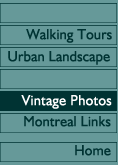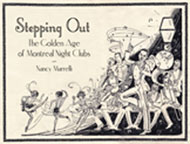 |
from
STEPPING OUT:
The Golden Age of Montreal Night Clubs
1925-1955
|
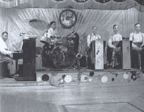 |
The Chinese Paradise was a popular club in Montreal's Chinatown; it was sometimes called the Chinese Paradise Grill. It was owned and operated by the Wong family. The club maintained a black entertainer policy until the spring of 1938 when many east-end clubs started switching to white acts. The club was located at 57 de la Gauchetière West.
|
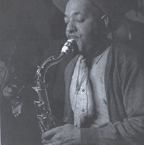 |
Musician Herb Johnson first came to Montreal in 1935, during the hard times of the Depression, and he ended up making the area home for the rest of his life. In the 1940s he joined Louis Metcalfe's International Band at Café St. Michel. Johnson did the arrangements of popular songs in the cutting edge be-bop style that the Metcalfe band introduced to Canada.
|
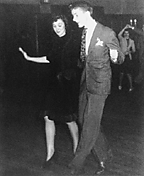 |
Dancers at the Johnny Holmes weekly Saturday Night Dance, Victoria Hall, 1942. From 1941-1950, Johnny Holmes organized weekly Saturday night dances at Victoria Hall, showcasing the Johnny Holmes Orchestra. The dances were very popular and became a Montreal institution. Between 1942 and 1948 Oscar Peterson was a featured member of the band. This photograph shows two unknown dancers at Victoria Hall stepping to the swing of Montreal's most successful big band of the 1940s.
|
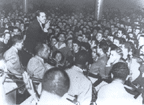 |
The Chez Maurice nightclub in the heart of downtown Montreal became Chez Maurice Danceland in the 1940s. It no longer served dinner or featured a floorshow. As the war progressed it came to be seen as unseemly that Montreal was enjoying itself so much and the number of clubs selling alcohol was reduced. Chez Maurice became one of the officially unlicensed Montreal dance clubs where teenages could dance to popular big-name American bands led by Cab Calloway (pictured here), Jimmy Dorsey, Duke Ellington, Jimy Lunceford and others. Patrons often came equipped with their own liquor in hip flasks.
|
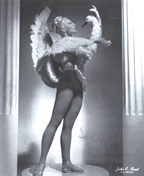 |
Exotic dancer and striptease artist Lili St. Cyr was the darling of Montreal audiences at the Gayety Theatre, the pre-eminent burlesque showcase in Montreal, from her first appearance there in March 1944. Her performances were original and artistic, with a particularly creative flair, and she was considered the "Queen of Strippers" in the 1940s and 1950s. Her act was sophisticated and always had a story line, in what was often described as an erotic ballet. |
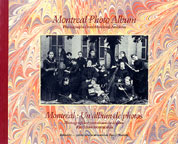 |
from
A MONTREAL PHOTO ALBUM:
Photos from Montreal Archives
|
 |
The head office of the Bank of Montreal on St. James Street (now St-Jacques) is one of Canada's architectural monuments. This imposing building with its sculpted pediment and portico with six fluted Corinthian columns was designed by Scottish architect John Wells in 1845, and was completed in 1847. The choice of Neo-Classical style was most appropriate to convey the bank's image of wealth and power. By 1940, when this photograph was taken, little more than the facade of Wells's original building remained. The interior had been remodelled in 1886, and in 1903-04 Stanford White of the New York firm McKim, Mead, and White, completely renovated and enlarged the banking hall and redesigned the dome. The facade and dome were restored in the late 1980s.
|
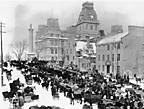 |
Market Day, Jacques Cartier Square, Montreal, c.1890. This long narrow square is located between Notre-Dame and St. Paul Streets and was originally part of the Marquis de Vaudreuil's estate, established in 1723. The Marquis' house was razed by fire in 1803, and the property was purchased by Perinaud and Durocher who divided it into lots, ceding a parcel to the city. The Marche Neuf on Place Jacques-Cartier opened as an outdoor market in 1804, and the Square welcomed produce and meat retailers until the early part of this century. Place Jacques-Cartier is currently a tourist area with a selection of outdoor cafes, souvenir shops, and restaurants. This photograph also shows Montreal City Hall. Architects H.M. Perrault and A.C. Hutchison designed the sumptuous Second Empire style building which was completed in 1878. City Hall was severely damaged by fire in 1922, and only the exterior stone walls survived. Reconstruction was completed in 1926, and it still serves as the seat of Montreal's municipal government.
|
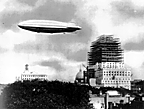 |
During the summer of 1930 the British dirigible R-100 visited Montreal as part of a campaign to establish a North American terminus for a transatlantic airship route. The craft was moored at the St. Hubert airfield on the South Shore. This photograph shows the dirigible passing over Dorchester Boulevard (now René-Levesque) and Mansfield. At the right is the Sun Life Building during the third phase of its expansion by the architectural firm of Ross & MacDonald. The central tower features a reinforced steel frame sheathed in grey granite rising to a height of 400 feet. It was the largest building in the British Empire at the time of construction.
|
|
|
|
|
